Further muddling the pitch, Amit Thackeray’s candidature has found support within the BJP even as the Eknath Shinde-led Shiv Sena, its ally within the Mahayuti alliance, has pitched a candidate who local BJP leaders are campaigning for.
Maharashtra votes for a new assembly on 20 November, and Mahim, which includes the neighbourhoods of Mahim, Dadar, and Prabhadevi, is one of the 36 constituencies in Mumbai.
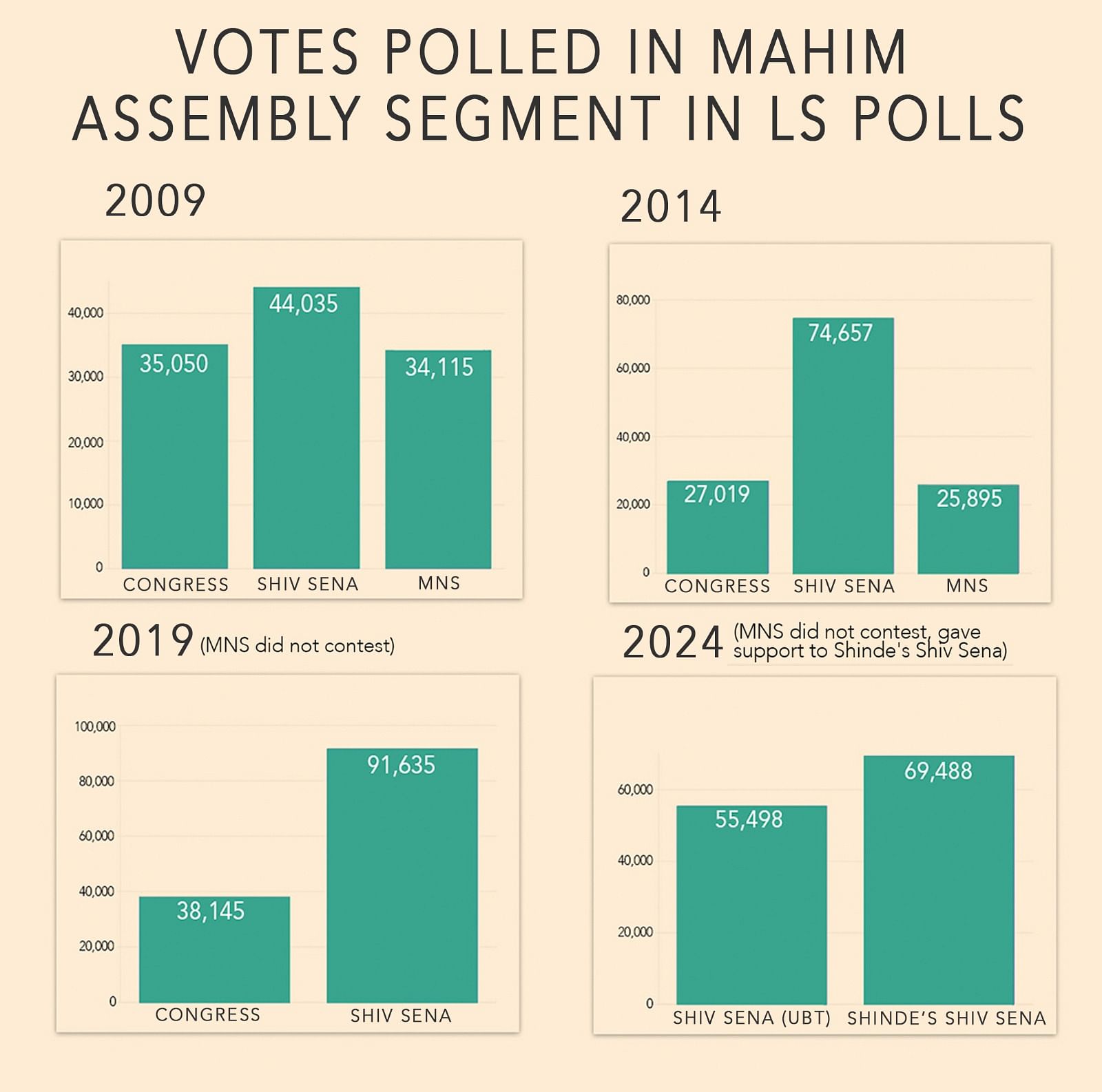
The undivided Shiv Sena was born in the constituency in 1966 with a rally at the landmark Shivaji Park. It witnessed an encore forty years later, with Raj Thackeray launching his MNS with a massive rally at Shivaji Park.
The Mahim assembly constituency has 2.34 lakh voters and is a motley mix of communities, including the upper-middle class, Marathi speakers living in high-rises, chawl dwellers, Catholics, and Muslims. The constituency has been a bastion of the undivided Shiv Sena since 1990, except from 2009 to 2014, when the MNS held the seat.
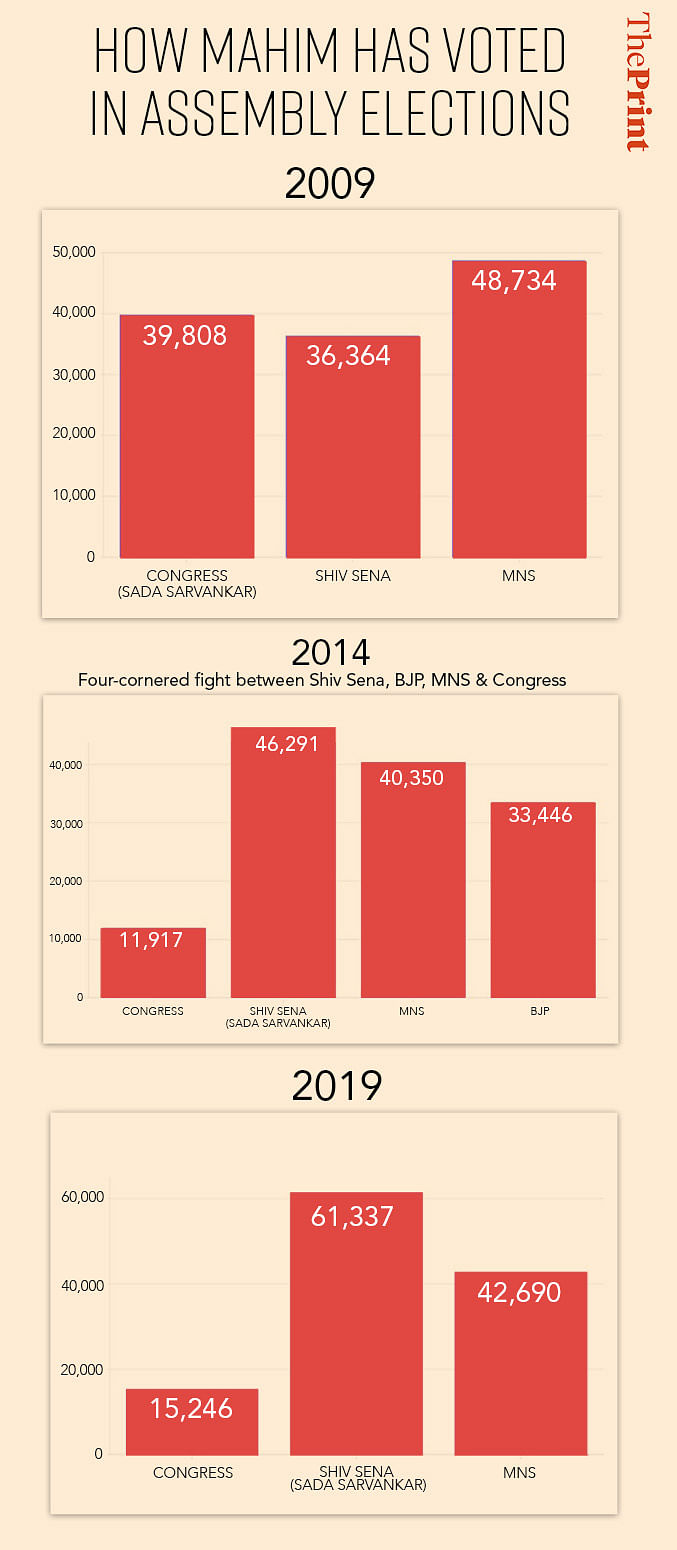
Offshoots of the same tree
In the triangular fight this time, all three candidates, Amit Thackeray from MNS, Sada Sarvankar from the Shinde-led Shiv Sena, and Mahesh Sawant from the Shiv Sena (UBT) are but the offshoots of the same tree, the undivided Shiv Sena founded by Bal Thackeray.
First, Raj Thackeray rebelled against his uncle Bal Thackeray, who overlooked him to anoint his son, Uddhav, as his successor. He walked out and formed the MNS in 2006, souring family ties.
Later, Sarvankar, the incumbent MLA of Mahim, elected on a ticket of the undivided Shiv Sena, walked to the Eknath Shinde camp after Shinde rebelled in 2022, causing a vertical split in the party.
Thirty-two-year-old Amit Thackeray’s biggest forte remains that he is Raj Thackeray’s son and that a mandate for him would make the MNS chief, known for his straight talk and aggression, directly responsible for the constituency.
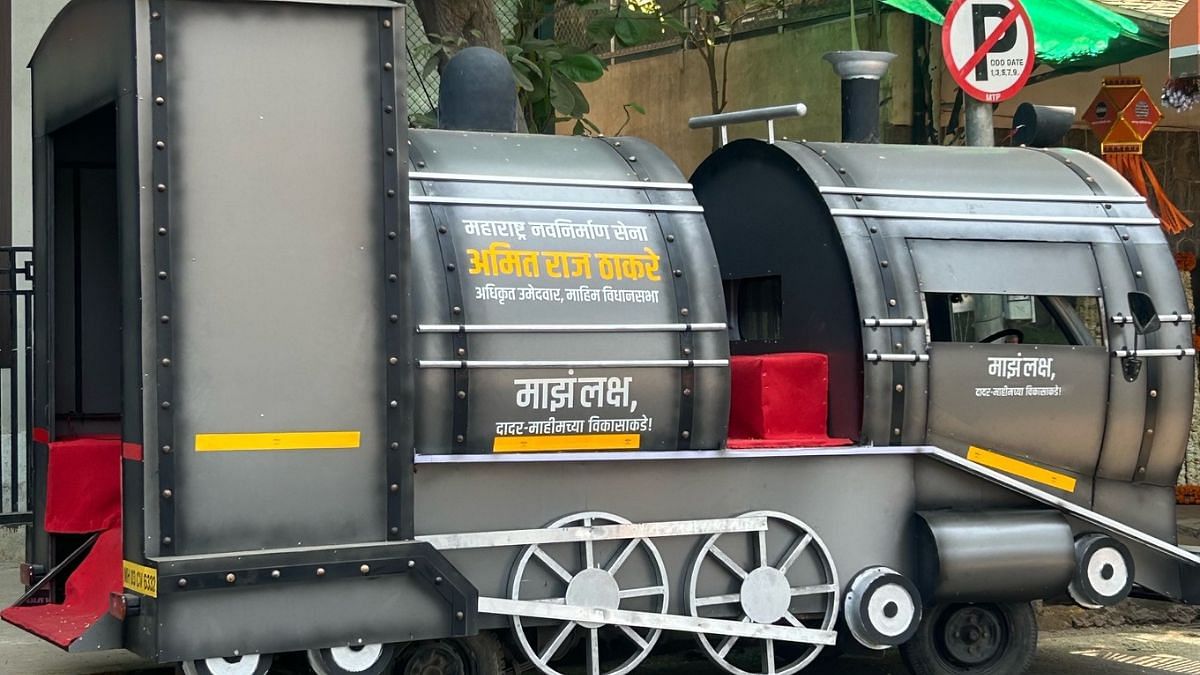
In an address to party workers after his nomination, Amit Thackeray said, “If we fall ill, go to a doctor, and the doctor’s medicine does not work, will we go to that doctor again? We will change the doctor. Our assembly constituency is also unwell, and an excellent surgeon sits at Shivtirth.”
Amit Thackeray was hinting at his father, Raj Thackeray. Their family bungalow at Shivaji Park is called Shivtirth.
Sarvankar from the Shinde-led Shiv Sena has represented the Mahim constituency for two terms. This time, he is banking on the support base he has so far built while talking up his work and talking down the two candidates against him as relatively inexperienced.
Till the eleventh hour, Sarvankar faced pressure to withdraw his nomination after the BJP, the largest partner in the Mahayuti, took the stand that the ruling alliance should back Amit Thackeray to avoid division of votes.
On Monday, the deadline for withdrawing nominations, Sarvankar told reporters that his son, Samadhan, and four of his supporters went to meet Raj Thackeray, requesting an appointment for the incumbent MLA to meet the MNS chief and discuss what to do with his candidature.
“Raj saheb said he had nothing to say, and it was up to me to decide whether to contest. We had no discussion. He even declined to meet. So what should a common karyakarta like me do?” Sada Sarvankar told reporters, announcing his decision to contest.
A day later, Sarvankar posted a video on his Facebook page of a resident of his constituency telling him that his decision to contest was a “Diwali gift” for the people of Dadar, Mahim, and Prabhadevi.
The third corner in the triangular contest, the Shiv Sena (UBT), has decided to play to its strengths, which lie in its robust ‘shakha system’ or organisational structure in Mumbai. Shakhas have been the lowest level of the party administrative units at the grassroots, running like a parallel administration system, attending to and resolving all sorts of public issues, from street lights to gutters to medical aid.
The Shiv Sena (UBT) candidate, Mahesh Sawant, though electorally inexperienced, has networked well in the constituency, having spent decades working in this shakha structure, climbing up the ladder within the party from a shakha pramukh to now a vibhag pramukh, that is, a division head of multiple shakhas.
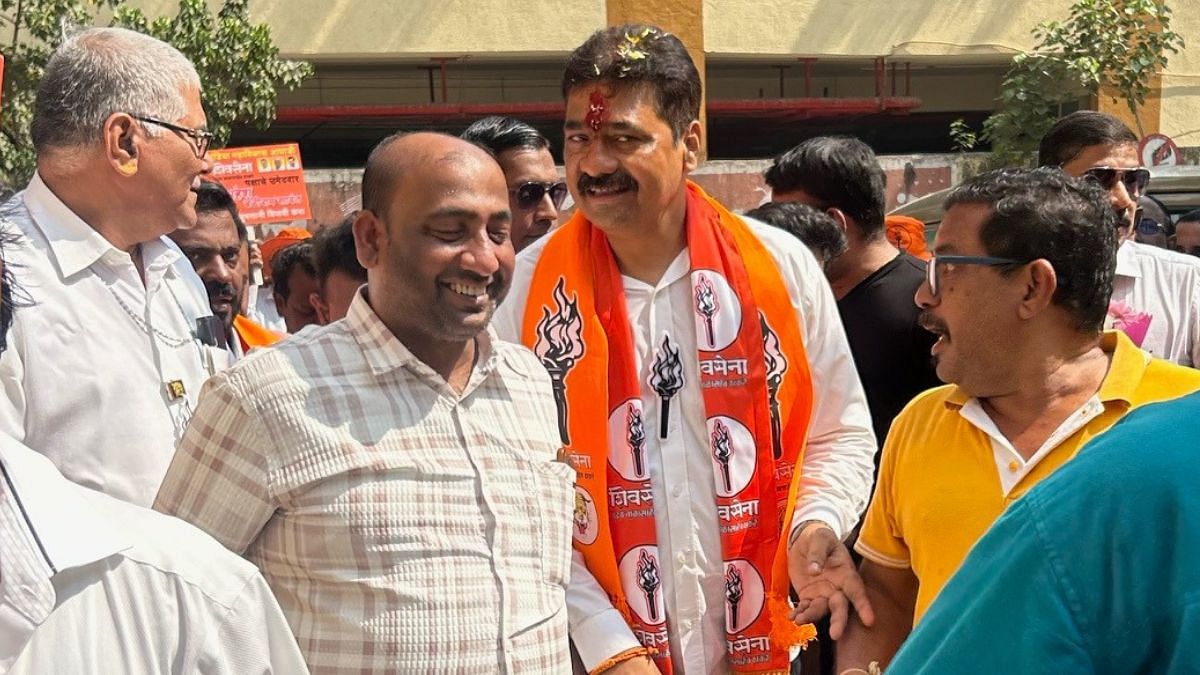
“I will be available at any time of the day or night when you call. That is my USP,” Sawant told a septuagenarian woman while campaigning door to door in a building of the Slum Rehabilitation Authority in Prabhadevi.
The Shiv Sena (UBT) is also banking on its newfound voter base—the Muslims in Mumbai—who have a significant presence in the Mahim assembly constituency.
Also Read: Deora vs Thackeray? Worli likely to see high-stakes battle between two scions
Two Shiv Senas, new friends and foes
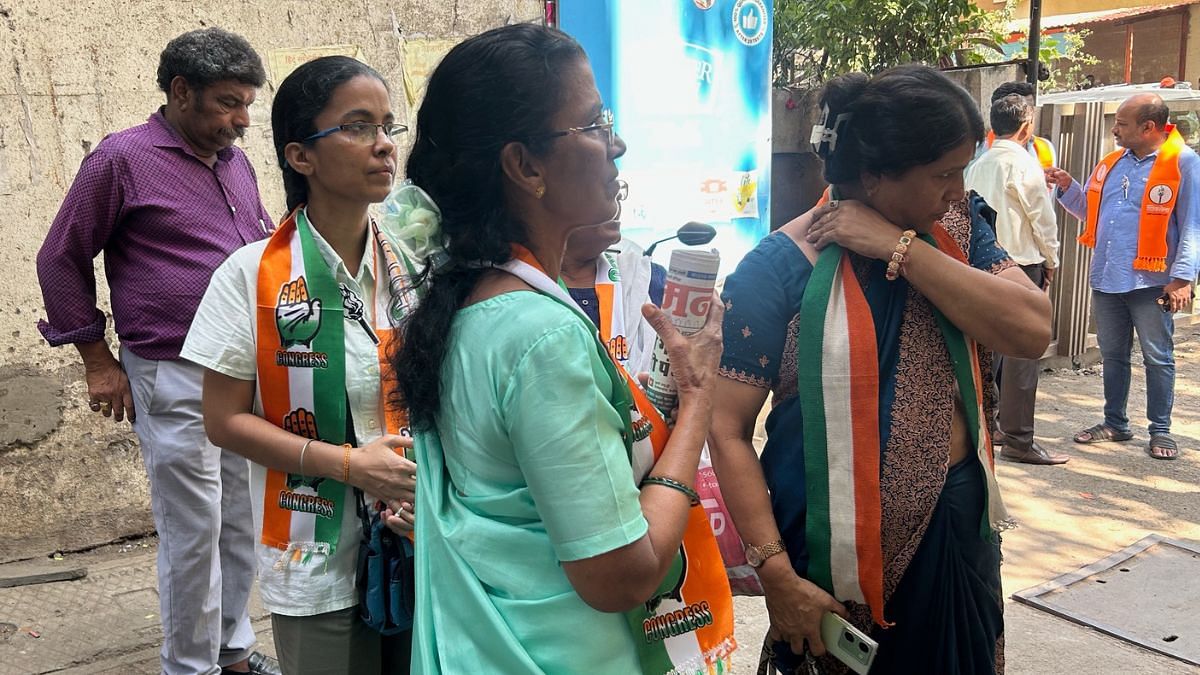
On Thursday, as Sawant and his wife Smita campaigned door to door in a predominantly Telugu-speaking locality of Prabhadevi, a group of his supporters with saffron sashes stood outside the building, handing out campaign material.
It was a quintessential sight of any election campaign trail. But, there was one thing that stood out. Among the saffron sashes of ‘mashaals’, the Shiv Sena (UBT)’s torch symbol, three Congress workers wearing sashes with their party’s ‘hand’ symbol distributed Saamana copies.
Saamana has been the Shiv Sena’s official mouthpiece, which, for years, was but a tool to slam the Congress, then a rival. The undivided Shiv Sena used to hit out at Congress through Saamana even after the party became its ally in 2019 as part of the Maha Vikas Aghadi (MVA). After the Shiv Sena split, Saamana remained with the Shiv Sena (UBT). Since then, it has been criticising the Shinde-led Shiv Sena and its ruling Mahayuti alliance.
“We do not expect any position or power. We are doing this because we care for the country’s future,” Nikita Reshma Nazareth, a Congress worker, told ThePrint. Nazareth’s mother, a Congress worker since late actor Sunil Dutt’s time as an MP, was by her side.
The building where they campaigned contained telltale signs—stickers and posters on the wall—of Sarvankar’s workers campaigning there not too long ago.
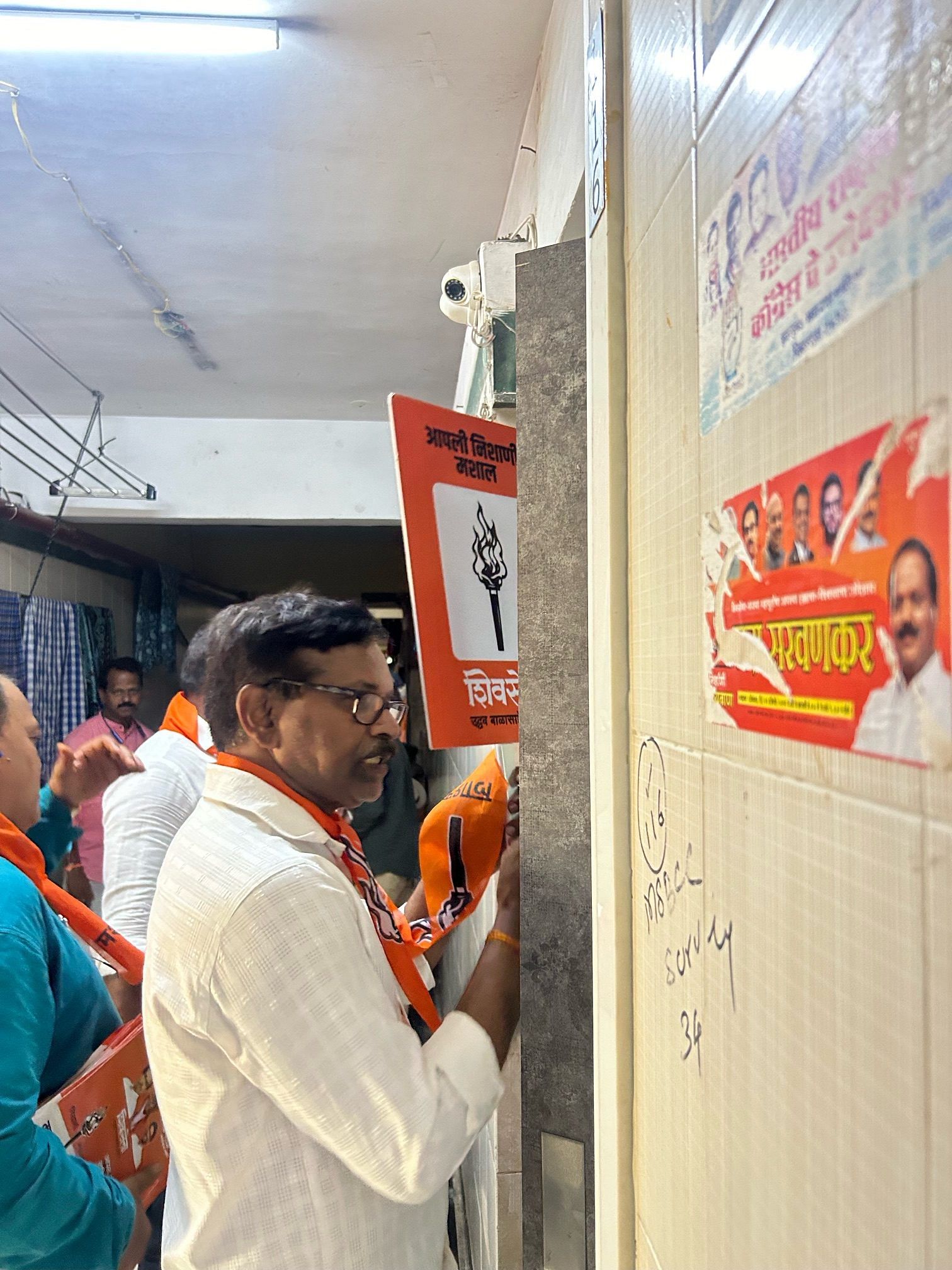
If the Lok Sabha elections are any indication, the Shinde-led Shiv Sena has an edge over the Shiv Sena (UBT) in the Mahim constituency.
The Mahim assembly segment is part of the Mumbai South Central parliamentary constituency. While Shiv Sena (UBT)’s Anil Desai won the Lok Sabha seat this time, Shinde-led Shiv Sena’s Rahul Shewale took the lead in the Mahim segment, with 69,488 votes against Desai’s 55,498 votes. In that election, the MNS did not field a candidate but backed the Mahayuti’s Shewale.
Sawant and Sarvankar, having politically grown under the same umbrella of the undivided Shiv Sena, share a choppy history.
“Mahesh dada worked hard for Sada Sarvankar as a shakha pramukh, but the latter damaged Mahesh dada’s chances of being a corporator by preferring his son instead,” Mahesh Kumbhar, a Shiv Sena (UBT) karyakarta, told ThePrint.
In the 2017 Mumbai civic polls, the undivided Shiv Sena had overlooked Sawant’s ambitions and fielded Sarvankar’s son from the ward Sawant desired.
Sarvankar briefly joined the Congress in 2009 after he was denied a ticket in the state assembly elections that year. Contesting the poll as a Congress candidate, he lost. As votes split three ways between the MNS, the Shiv Sena, and Sarvankar, the MNS, that election, registered its first and only victory from the constituency.
“Today, it is a similar situation with three players, but the Shiv Sena (UBT) has a slight advantage. Only that party can attract the Muslim population in the constituency, and they will be the swing,” Satish Valanju, a veteran Shiv Sainik, who, in 2010, led an unsuccessful ‘Thackeray jodo campaign’ to reunite cousins, Raj and Uddhav. He is now out of active politics.
Despite the Shiv Sena’s contentious history with the Muslim community, the Shiv Sena (UBT) pulled many Muslim votes in Mumbai during the Lok Sabha election earlier this year, fighting the poll as a part of the MVA.
Valanju said, “You have BJP leaders who make statements such as vote jihad and call for consolidation of Hindus. But, when you call for consolidation of one community against the other, the other unites and comes out to vote decisively. That is the edge the Shiv Sena (UBT) has here.”
He said that Raj Thackeray, on the other hand, has burnt bridges with the Muslim community by leading a statewide agitation against mosque loudspeakers in 2022.
Yashwant Killedar, an MNS leader from the Mahim constituency, said his party is not against Muslims, their prayers, or mosques.
“We are against noise pollution. Raj saheb has also spoken against using DJs and Dolby speakers during the Ganpati festival. We will remind the Muslim community voters of our stand,” he said.
Also Read: Why stakes are high for BJP & INDIA bloc as Maharashtra, Jharkhand go to polls
The MNS and its scion
On Tuesday, as Amit Thackeray was campaigning in the thick residential areas of Prabhadevi, dressed in a formal maroon kurta and white pyjama, he broke into a game of football with a group of boys on the beach. Several passersby stopped to watch, and Amit Thackeray’s team decided to use the video as a part of his campaign—packaged neatly with Hanuman Kind’s popular rap, ‘Big Dawgs’, as the background score.
“The MNS has built a committed vote bank in this constituency, which will come to us. Uddhav Thackeray’s committed voters will go with Sawant. Sarvankar’s following will go to him. But, the young voters will come to us as Amit Thackeray is relatable. We have an edge there,” Killedar said.
“The young voter is otherwise very disillusioned with all politics. Amit Thackeray’s candidature will galvanise them to come out and vote,” he added.
In 2009, the MNS played spoiler for the undivided Shiv Sena in the Lok Sabha elections in the Mumbai South Central constituency by getting 18.1 percent of the total votes. With 1,08,341 votes going to the MNS candidate, the undivided Shiv Sena lost the seat to then-rival Congress by 75,706 votes. In the Mahim assembly segment alone, MNS polled 28.9 percent of the votes against the Shiv Sena’s 37.2 percent.
In the assembly elections in the same year, Raj Thackeray’s party dislodged the Shiv Sena from the Mahim seat. Nitin Sardesai from the MNS got 37.8 percent votes and won with a margin of 8,926 votes. Sarvankar, then with the Congress, came second, and the Shiv Sena third.
The MNS dealt the most severe blow to the Shiv Sena during the Mumbai civic polls in 2012 when it won all seven councillor seats in the Dadar-Mahim area.
However, from 2014 onwards, the party’s electoral fortunes started fading across the state. The MNS lost the Mumbai South Central constituency by a wide margin in 2014. Even in the Mahim assembly segment, it secured the third position, with 25,895 votes against the undivided Shiv Sena’s 74,657. The Shiv Sena fought the election in an alliance with the BJP and benefitted from the Narendra Modi wave.
In the assembly election that year, in a four-cornered contest between the BJP, Shiv Sena, MNS and Congress in Mahim, MNS leader Nitin Sardesai, with 40,350 votes, ended up in second position. The Shiv Sena secured the majority of votes, 46,291, after Sarvankar returned to its fold and contested on its ticket.
In 2019, the MNS sat out the Lok Sabha election. The party contested the 2019 assembly election and posted a dismal performance across the state, except in Mahim, where it lost the seat to Sarvankar but drew 35.5 percent of the vote share against the undivided Shiv Sena’s 51.1 percent. The BJP and the Shiv Sena fought that election in an alliance.
Ten years ago, the disclaimer about MNS being a vote-cutter and indirectly helping the Congress party may have dented the party. The disclaimer now about it helping the BJP could play out differently.
“The anti-BJP votes here mainly come from the Muslims and other minorities. Among the area’s Marathi population, the anti-BJP vote is not major,” political commentator Abhay Deshpande told ThePrint.
“There is a traditional Marathi vote of the MNS here—which will be loyal to the party, more so this time because Raj Thackeray has fielded his son,” he added.
(Edited by Madhurita Goswami)
Also Read: In Maharashtra’s muddled political landscape, Owaisi’s AIMIM has kingmaker dreams













